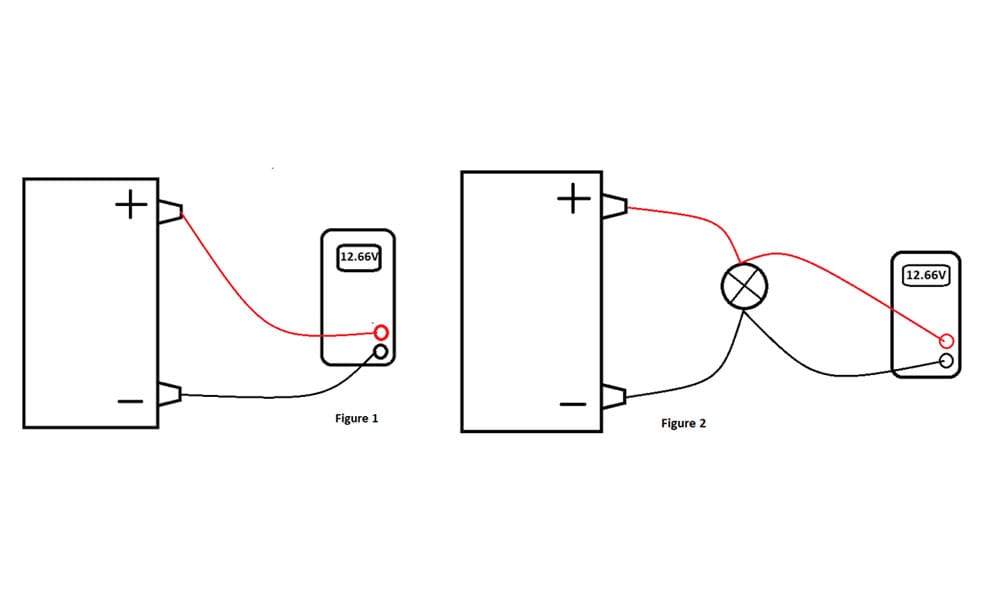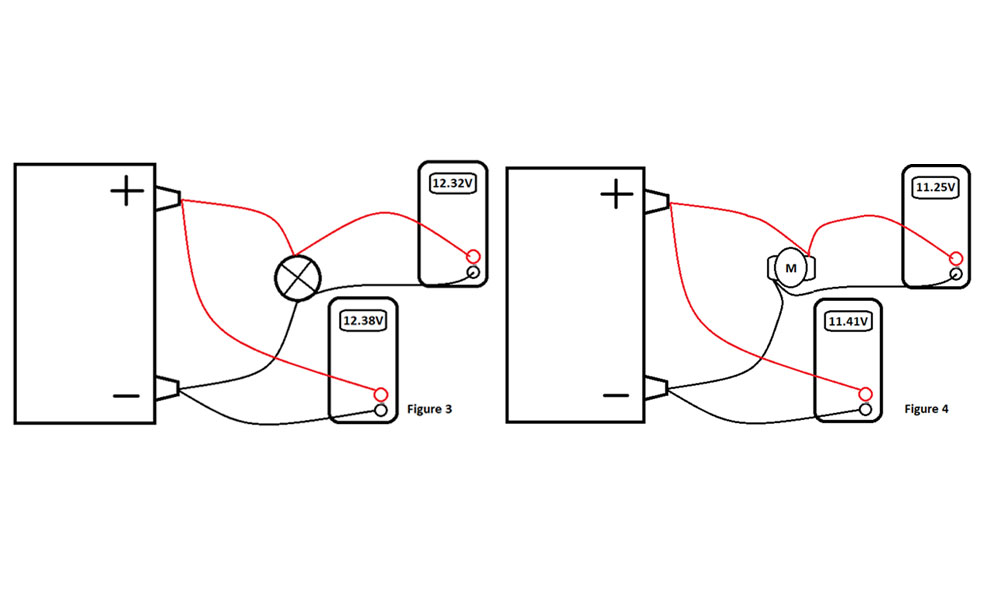By Kevin Roberts
In the last article we discussed the definition of Voltage and how intended Voltage Drops appear in a circuit.
Today, we will suggest some non-intrusive and time-saving tests. By performing these routinely, they can become second nature. These allow us to retrieve a significant amount of pertinent information and there may be times when these are the only tests needed.
In the attached Figures, all the switches and fuses have been eliminated so that we may focus on the basic principles.

If you look at Figures 1 and 2 above, you will see, with a very minimal load on the circuit, an identical voltage reading on the meter. The informed technician will, however, see at once the obvious distinction between these two readings.
Figure 1 shows what the battery voltage is. This is independent of any circuit connection. Figure 2 shows what is available to the bulb while it is connected to the battery. This distinction is between Voltage Potential at the source, and Voltage Drop at the load. Even though we find voltage, we would not call Figure 1 a Voltage Drop.
What do we call Figure 1?
We call Figure 1 Open Circuit Voltage (OCV). We recommend this test as the first performed on any rig with an electrical symptom. OCV informs the technician of the State of Charge of the battery without any applied loads. We perform this test first to bring us to a “fork in the road.” If we are close to full charge, we may proceed to the next step of diagnosis. If not, say at 12.3 Volts or less, (FLA, Flooded Lead Acid battery) we should charge the battery before proceeding with any further diagnosis. This is important, because in this age of computer control, if the OCV shows the battery State of Charge to be low, turning on the key to perform testing can drive the voltage lower and could cause any computer to become stupid starved for voltage. This, in turn, can cause the results of further testing to be inaccurate.
If the OCV is sufficient to continue testing, we can turn on the symptomatic load and continue our diagnosis. In the last article, I mentioned that the Voltage at the bulb in Figure 2 above would be less than that of the battery. Practically, there are two reasons for this:
- First, it will be less than battery OCV. By adding a load to the battery, we begin discharging the battery. We no longer call this Open Circuit Voltage because some of the circuits are now closed. Before we closed any circuits, the battery was not doing much more than if it were sitting on a shelf in the parts room. Also, this is a reason for not supporting the battery voltage every time you perform an electrical test. Doing so will, in this case, mask a deteriorated battery. (Yes, there are very few loads on a modern Emergency Vehicle electrical system that can be turned on without turning on other loads, but here we want to minimize distractions from the main principle)
- Second, since no conductor is perfect, the voltage at the load when connected, will be somewhat less than at the battery.
After we close the circuit, we need to know if the battery can maintain voltage during operation of that circuit. For this we use the term Source Voltage. The battery has now become the Source for any connected loads. I suspect that many of my readers may have seen a battery show strong OCV until a load is applied. OCV only describes the State of Charge, not the health of the battery. Once the OCV becomes Source Voltage, the voltage of a weak battery may drop dramatically.

If the Source Voltage test shows a strong battery with a light load (see lower meter in Figure 3) or with a heavy load (see lower meter in Figure 4), we then need to verify how much of that Source Voltage is making it to the load in question. This is what we call Available Voltage and we test it at the load. If we see too large of a discrepancy between the Source Voltage and the Available Voltage, we have discovered the existence of an unwanted Voltage Drop. The key here is, as Figures 3 and 4 show, both measurements are performed under similar conditions.
This is a test of the ability of the harness to support current flow to the load. If all three tests pass, we have reason to believe that the fault is with the load itself. (Notice we have not defined what is a “pass” in the preceding sentence. There are too many variables to even try.)
If the Available Voltage test shows a significant difference from Source Voltage, we apply Kirchhoff’s Voltage law. This law states that all Voltage Drops in a series circuit will add up to Source Voltage. The difference between Source and Available Voltage is what we refer to as Voltage Drop. If excessive, we need to find if the Voltage Drop is in the Positive or Negative Harness.
On a practical note, the reason we evaluate Available Voltage before going directly to the positive and negative sides for the circuit looking for the location of a possible Voltage Drop is this: The location of the load, (the component that is symptomatic) may not be very close to the Source. Verifying Available Voltage may prevent us from having to unnecessarily stretch test leads the full distance from the battery to the component.
Notice that we have not limited ourselves to a specific load or type of load. Yes we do have a bulb in Figures 1-3, but the process and the resultant findings are legitimate whether we are testing a headlight circuit on a 2022 Administrative Suburban or a starter on a 1953 American LaFrance V-12.
To summarize: Testing for OCV, Source, and Available Voltage allows us to quickly evaluate the battery, the load, and the harness without any intrusion that may skew the results.
Next time we dive deep into Kirchhoff’s Voltage Law and Available Voltage.






